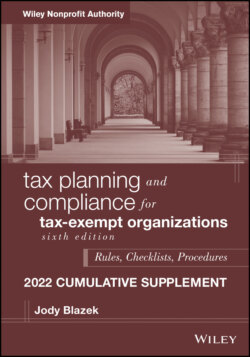Читать книгу Tax Planning and Compliance for Tax-Exempt Organizations - Jody Blazek - Страница 40
Оглавление§ 3.2 Churches
(b) Definition of Church
p. 69. Add new paragraphs at end of subsection:
Upon examination, the IRS found that a nonprofit organization was not only not a church, but also did not meet the factors identifying a § 501(c)(3) tax-exempt organization as the IRS had originally determined from information provided when the organization sought recognition of tax-exemption. The questions on Form 1023 are listed below. It is important to note that they do not follow the 14-point test set forth in 1994 in the order listed on pages 66 and 67 and ask additional questions. In completing Form 1023 for a new “church,” and subsequent conduct of church activities, attention to the factors on the test is critical.1
1. Provide a brief history of the development of the organization, including the reasons for its formation.The history of this organization is simply the coming together of a group of people for the purpose of worshipping God. The reason for its formation is to facilitate the sharing of this belief and form of worship with others.
2. Does the organization have a written creed or statement of faith? If “Yes,” attach a copy.The organization checked “yes” but there appears to be no written creed or statement of faith attached.Questions 3–5 are not listed in the private letter ruling.
6. Are the services open to the public? If “Yes,” describe how the organization publicizes its services and explain the criteria for admittance.The organization checked “Yes” and provided the following statement:There is no criteria of admittance—all are welcome. Publicity will be word of mouth, telephone directory, and a sign on location.
7. Explain how the organization attracts new members.Word of mouth, telephone directory, and a sign on location.
8a. How many active members are currently enrolled in the church?
8b. What is the average attendance at the worship service?
9. In addition to worship services, what other religious services (such as baptisms, weddings, funerals, etc.) does the organization conduct?Baptisms, weddings, funerals, baby dedications.
11. Were the current deacons, minister, and/or pastor formally ordained after a prescribed course of study?No
12. Describe the organization’s religious hierarchy or ecclesiastical government.Led by a Pastor, governed by a council.
13. Does the organization have an established place of worship?NoIf the organization has no regular place of worship, state where the services are held and how the site is selected.In home site and other meeting sites chosen by oral agreement. State of meeting sites decided upon by oral agreement.
16. Show how many hours a week the minister/pastor and officers each devote to church work and the amount of compensation paid to each of them. If the minister or pastor is otherwise employed, indicate by whom employed, the nature of the employment, and the hours devoted to that employment.Pastor devotes 8–16 hrs per week—monthly compensation $0. He is otherwise self-employed as a general contractor 30–40 hrs a week.
17. Will any funds or property of the organization be used by any officer, director, employee, minister, or pastor for his or her personal needs or convenience?No
18. List any officers, directors, or trustees related by blood or marriage.None
19. Does the church have a recognized creed and form of worship? If so, please provide a detailed description of this information or documentation that will demonstrate its existence.Yes. Our name comes from our desire to worship the Lord as a community. To love Him with all our hearts and to worship Him in truth. John 4:24: “God is Spirit, and those who worship Him must worship in spirit and truth.” Deut. 6:5–7: “You shall love the Lord you God with all your heart, with all your soul, and with all your strength.” “And these words which I command you today shall be in your heart.” “You shall teach them diligently to your children, and shall talk of them when you sit in your house, when you walk by the way, when you lie down, and when you rise up.” Matt. 22.37–40: “Jesus said to him, “You shall love the Lord your God with all your heart, with all your soul, and with all your mind.” “This is the first and great commandment. And the second is like it: ‘You shall love your neighbor as your self.’ On these two commandments hang all the Law and the Prophets.”
20. Does the church have a definite and distinct ecclesiastical government? If so, please provide a detailed description of this information or documentation that will demonstrate its existence.Yes. Eph. 5:21 “and be subject to one another in the fear of Christ.” We have pastors and elders, but everyone has a voice.
Incidental church-like activities, like training missionaries, do not necessarily make a religious organization a church.2 Early GCMs from the Treasury Department carefully explained and parsed out the rules to distinguish those activities that are conducted by and will qualify an entity as a “church” versus those that conduct activities that are “religious,” a word on the § 501(c)(3) list of purposes that qualify for tax-exemption. As this chapter evidences, the attributes and qualification are distinct. Each subject has more than five pages in separate sections.
